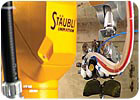A Vision for Automation: Robotic Spraying
Several years ago, BOLLÉ decided to automate its varnish-spraying operation for the lenses of its welding and ski goggles. Installing a robotic spraying system has allowed the manufacturer to increase quality and productivity.

BOLLÉ, founded in 1888 in the Oyonnax valley of France, is among the leaders in the eye protection market, including sunglasses, sports goggles and protective masks. Several years ago, the company decided to automate its varnish-spraying operation for the lenses of its welding and ski goggles. The reason for automation was twofold: The company wanted to improve the quality of the application process, and thus reduce the number of rejected items, and it also wanted to increase productivity by decreasing downtime.
The company installed a cleanroom paint spray booth using a Stäubli RX60L Paint robot for the spraying process. Today BOLLÉ produces more than 5,400 items per day in a three-shift operation using the robotic system.
Outside the booth, in a controlled environment, the operator loads the lenses into baskets that are then transferred to the ultrasonic cleaning line. The lenses are then dried and taken to the cleanroom booth, where an operator sets the lenses, one by one, onto a four-position indexing table. The robot and controller manage the complete process.
After the loading operation, the first stage consists of a final dust-removal and deionization process, which neutralizes the electrostatic charge. The next station is the spray station. Here, the robot uses complex trajectories to optimize the application of the varnish, taking into account the curvature of the lenses. The robot then sprays the anti-scratch varnish onto the lenses as they pass in front of the system. The final station is a degassing area where the varnish partially dries and becomes smooth. As soon as the varnish has cured, the same operator unloads the lenses and positions them in the baskets for transfer to the drying tunnel. Outside the booth, the lenses are then inspected and packed.
The robot carries out the spraying operation with an average cycle time of only 3.5 seconds per item. Because of the precision of its movements, the robot has improved quality by applying the varnish more evenly, lowering the reject rate by 15 to 20%. Through reduced labor and improved productivity, the cell paid for itself in less than two years, and it has provided trouble-free operation since it was installed.
For more information about robotic finishing systems, contact David Arceneaux, Staubli Corp. Robotics Division at d.arceneaux@staubli.com or visit www.staublirobotics.com. BOLLÉ’s website is at www.bolle.fr.

The robot uses complex trajectories to optimize the application of the varnish, taking into account the curvature of the lenses.
BOLLÉ, founded in 1888 in the Oyonnax valley of France, is among the leaders in the eye protection market, including sunglasses, sports goggles and protective masks. Several years ago, the company decided to automate its varnish-spraying operation for the lenses of its welding and ski goggles. The reason for automation was twofold: The company wanted to improve the quality of the application process, and thus reduce the number of rejected items, and it also wanted to increase productivity by decreasing downtime.
The company installed a cleanroom paint spray booth using a Stäubli RX60L Paint robot for the spraying process. Today BOLLÉ produces more than 5,400 items per day in a three-shift operation using the robotic system.
Outside the booth, in a controlled environment, the operator loads the lenses into baskets that are then transferred to the ultrasonic cleaning line. The lenses are then dried and taken to the cleanroom booth, where an operator sets the lenses, one by one, onto a four-position indexing table. The robot and controller manage the complete process.
After the loading operation, the first stage consists of a final dust-removal and deionization process, which neutralizes the electrostatic charge. The next station is the spray station. Here, the robot uses complex trajectories to optimize the application of the varnish, taking into account the curvature of the lenses. The robot then sprays the anti-scratch varnish onto the lenses as they pass in front of the system. The final station is a degassing area where the varnish partially dries and becomes smooth. As soon as the varnish has cured, the same operator unloads the lenses and positions them in the baskets for transfer to the drying tunnel. Outside the booth, the lenses are then inspected and packed.
The robot carries out the spraying operation with an average cycle time of only 3.5 seconds per item. Because of the precision of its movements, the robot has improved quality by applying the varnish more evenly, lowering the reject rate by 15 to 20%. Through reduced labor and improved productivity, the cell paid for itself in less than two years, and it has provided trouble-free operation since it was installed.
For more information about robotic finishing systems, contact David Arceneaux, Staubli Corp. Robotics Division at d.arceneaux@staubli.com or visit www.staublirobotics.com. BOLLÉ’s website is at www.bolle.fr.
Looking for a reprint of this article?
From high-res PDFs to custom plaques, order your copy today!




